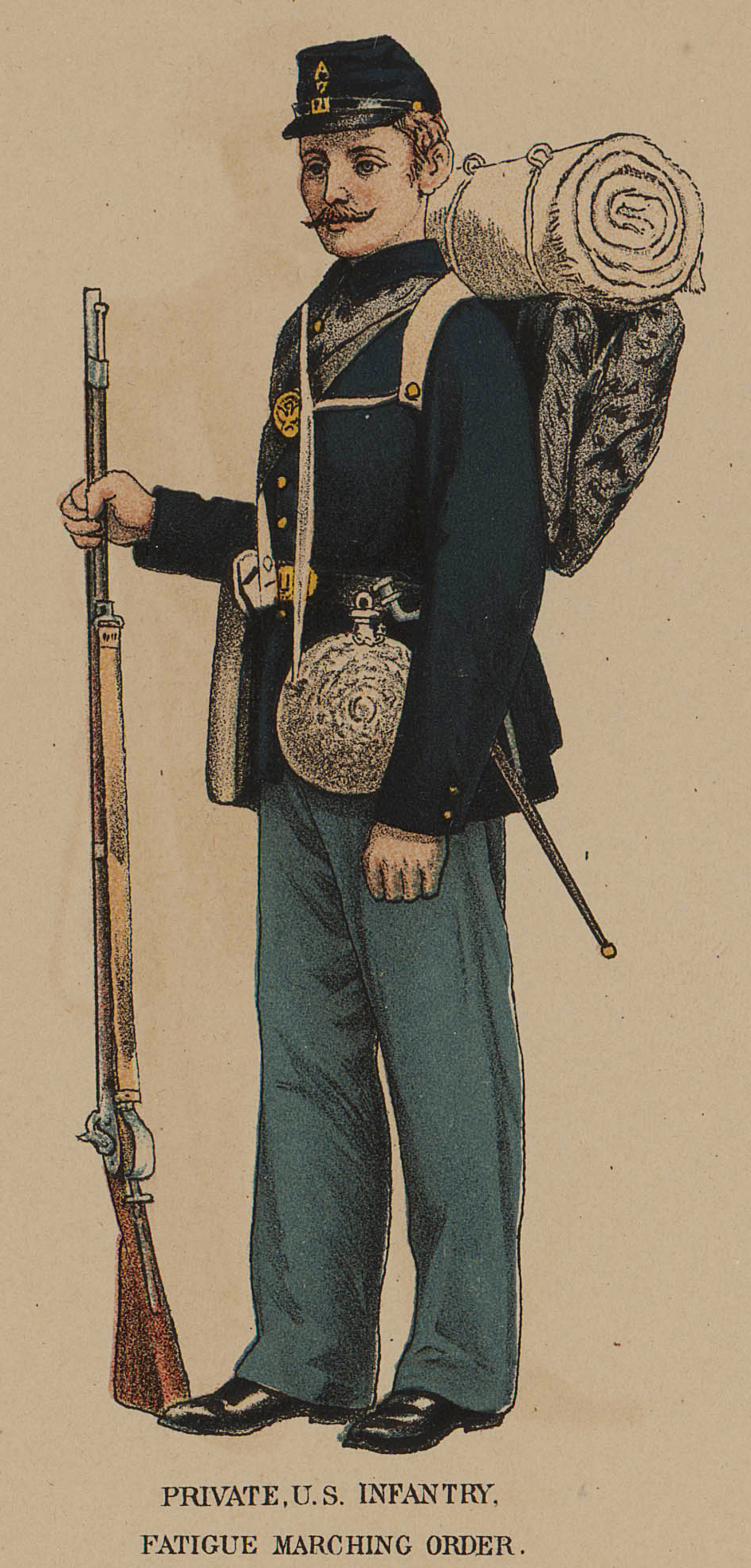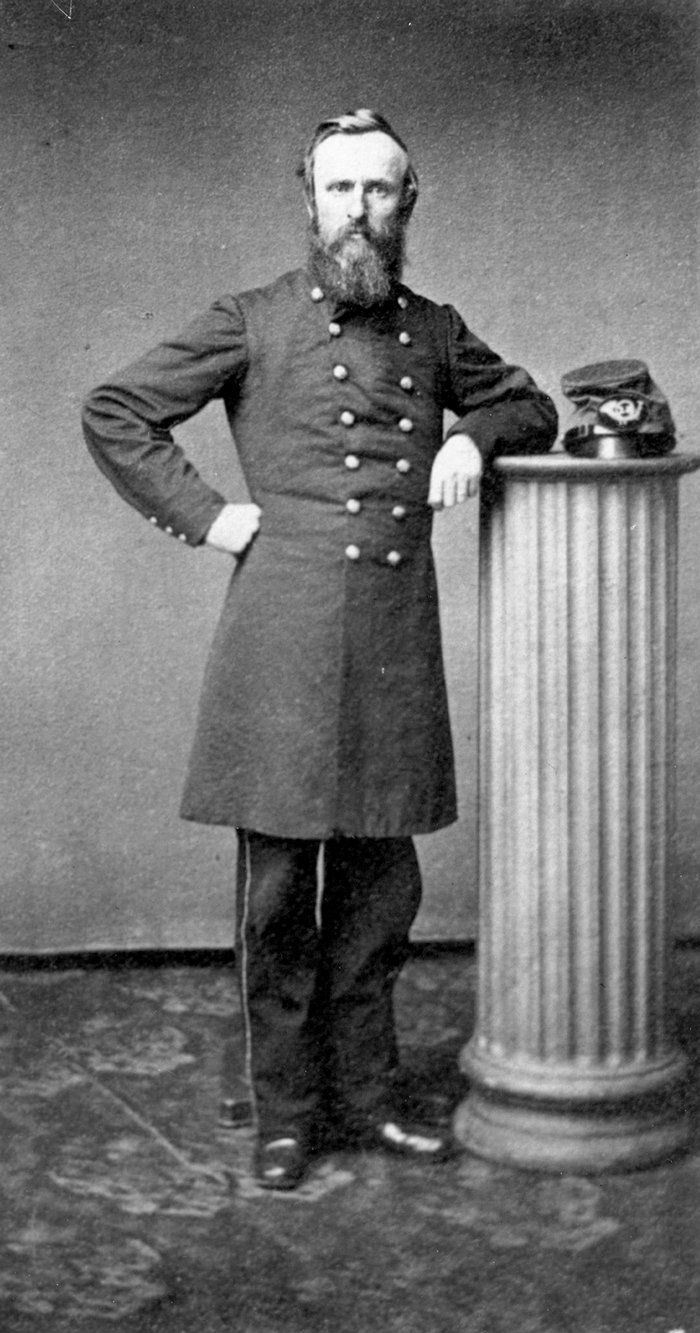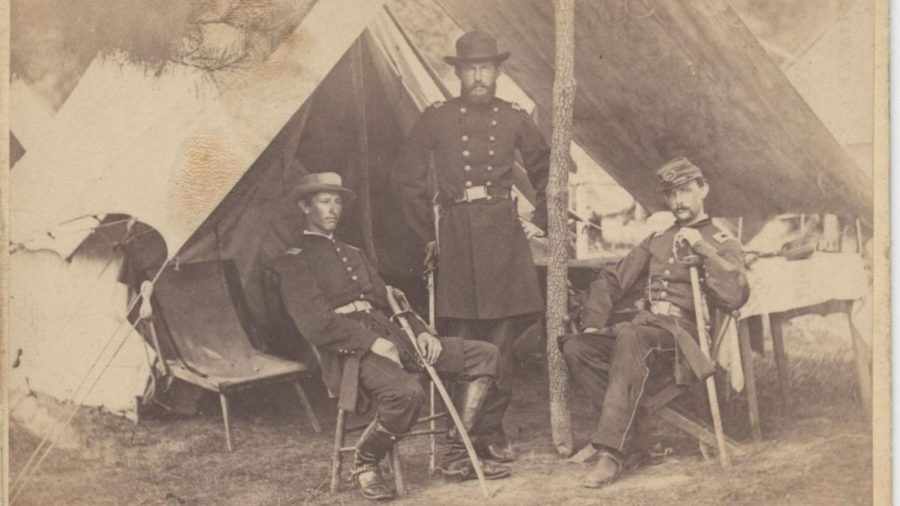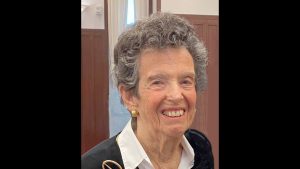Civil War seder memorialized 161 years later
U.S. Civil War Union officers in tent (1862). Photo courtesy of Penn State Special Collections via Flickr at https://www.flickr.com/photos/pennstatespecial/6346867231/in/photostream/
Published March 31, 2023
This story was originally published by the Pittsburgh Jewish Chronicle and is republished here with full permission.
Private Joseph A. Joel noticed on his calendar that Passover was coming. He and 20 fellow Jewish soldiers requested relief from duty to celebrate the holiday with a seder. Permission was granted. Despite the soldiers’ remote location, they acquired matzah and other Passover products. The young men built an area for services, held a seder, recalled the Exodus and offered blessings, while the Civil War raged around them.
Now, 161 years later, Joel and his compatriots’ efforts are being preserved as a reminder of the contributions and commitment of Jewish soldiers during the Civil War.
On April 3, a sign bearing testament to the Jewish troops and their commanding officer — future President Rutherford B. Hayes — will be unveiled in Fayetteville, West Virginia.
A corresponding ceremony, scheduled for 11 a.m. at Love, Hope, Center for the Arts, will be a reminder that “the original cast of the Civil War is more diverse than maybe we believe it today,” said Drew Gruber, executive director of Civil War Trails, an organization that partners with communities in Virginia, Maryland, West Virginia, North Carolina, Tennessee and Pennsylvania to connect visitors to meaningful Civil War narratives.
What Joel and the other Jewish soldiers did 161 years ago was a “bright spot and peaceful moment” during a period marked by carnage, Gruber said.
Between 1861 and 1865, approximately 620,000 soldiers died on U.S. soil. The sum is about equal to the number of American fatalities in the Revolutionary War, the War of 1812, the Mexican War, the Spanish-American War, World War I, World War II and the Korean War combined, according to the National Parks Service.
While the deaths, military conflicts and commanders have long captivated historians, the Civil War “isn’t just about battles and campaigns, but about humanity, and in this instance, community,” Gruber said.
Jewish soldiers wanted to celebrate Passover “but it was a wider community” that made it happen, which makes a fascinating parallel to today, researcher Victoria Tolson explained.

Tolson, an administrative assistant with Civil War Trails, worked with private collectors and members of West Virginia’s Jewish community to unearth details regarding the 1862 seders and Joel.
Born in Plymouth, England, on May 27, 1844, Joel enlisted in the Union Army, 23rd Ohio Infantry, on July 7, 1861. Less than two years later, he was discharged on Feb. 9, 1863, “after having sustained eight gunshot wounds, and losing the tips of two fingers,” according to documents shared by the Shapell Manuscript Foundation.
Joel’s wartime efforts earned the respect and lifelong friendship of his commanding officer, Rutherford B. Hayes. Following the Civil War, the two corresponded extensively. They shared updates about their families and personal health. Hayes called Joel a “dear comrade” and invited him to the Executive Mansion (a precursor to the White House). Joel named his son Rutherford B. Hayes Joel.
In 1873, Hayes described that honor, by writing, “I am proud of your partiality and shall always regard with great interest the progress of the young gentleman. I shall try to remember him in some substantial way. Let him be as brave and honorable as his father and he will be a credit to his parents and namesake.”
Years before that correspondence, Hayes gave Joel and the other Jewish soldiers a reprieve to celebrate Passover. The landsmen, according to Joel’s 1866 writings, hired their Jewish sutler to go to Cincinnati and buy matzah.
“About the middle of the morning of Erev Pesach, a supply train arrived in camp, and to our delight seven barrels of Matzos,” Joel wrote. “On opening them, we were surprised and pleased to find that our thoughtful sutler had enclosed two Haggadahs and prayer-books.”
The delivery was a start, but to truly mark the holiday the young men needed other supplies.
“We held a consultation and decided to send parties to forage in the country while a party stayed to build a log hut for the services,” Joel wrote. The foragers were successful and the soldiers obtained “two kegs of cider, a lamb, several chickens and some eggs. Horseradish or parsley we could not obtain, but in lieu we found a weed, whose bitterness, I apprehend, exceeded anything our forefathers ‘enjoyed.’”

The Jewish soldiers had almost all the necessary items, but they reached a quandary: “We had the lamb, but did not know what part was to represent it at the table.”
Thankfully, “Yankee ingenuity prevailed,” Joel noted, “and it was decided to cook the whole and put it on the table, then we could dine off it, and be sure we had the right part.”
The seder plate was virtually in order, but the young men realized they lacked charoset. Despite trying, they couldn’t get the necessary ingredients, so once again, they relied on their Yiddishe kops.
“We got a brick which, rather hard to digest, reminded us, by looking at it, for what purpose it was intended,” Joel wrote.
The Jewish teen then led his comrades in prayers. The evening went well until the group reached Maror — the portion of the seder in which the bitter herb is eaten — and the “horrors” began.
“What a scene ensued in our little congregation, it is impossible for my pen to describe,” Joel wrote. “The herb was very bitter and very fiery like Cayenne pepper, and excited our thirst to such a degree, that we forgot the law authorizing us to drink only four cups, and the consequence was we drank up all the cider. Those that drank the more freely became excited, and one thought he was Moses, another Aaron, and one had the audacity to call himself Pharaoh. The consequence was a skirmish, with nobody hurt, only Moses, Aaron and Pharaoh, had to be carried to the camp, and there left in the arms of Morpheus.”
The episode was memorable, but not only because of the bitterness and drink.
“There, in the wild woods of West Virginia, away from home and friends, we consecrated and offered up to the ever-loving G-d of Israel our prayers and sacrifice,” Joel wrote. “I doubt whether the spirits of our forefathers, had they been looking down on us, standing there with our arms by our side ready for an attack, faithful to our G-d and our cause, would have imagined themselves amongst mortals, enacting this commemoration of the scene that transpired in Egypt.”
Part of what makes this seder so incredible, Gruber said, is Joel’s appreciation. The Ohioan went through multiple battles — including Antietam, which begat the Emancipation Proclamation — and, yet, later in life, returns to this week of Passover as being one of his greatest experiences.
“I’ve never seen a Civil War story like this,” Gruber noted.
Since 1994, the organization Gruber heads has worked with communities, historians and descendants to place markers and preserve local narratives.
“We have over 1,400 Civil War Trails sites,” Gruber said. The soon-to-be dedicated sign in Fayetteville is the “first Civil War Trails site in the nation that lifts up the story of Jewish soldiers … It’s beautiful.”
For Tolson, the tale offers a different resonance.
“There’s not enough about us, to be honest, even though we’ve been here the entire time,” the Jewish Virginian said. “There have been Jewish people in Virginia and West Virginia from the 18th century … so, of course, they would be celebrating a seder during the Civil War.”
Tolson credited Jewish Appalachians, like Dr. Joseph Golden of Temple Beth El in Beckley, West Virginia, with preserving and transmitting this account and other local Jewish history.
The thing about Joel’s saga is it’s “something a lot of young Jewish people can relate to,” Tolson said.
Joel and his fellow Ohioans were basically teens who found themselves far from their Cincinnati homes. The wider community provides some Passover items, but much of the holiday’s observance is fashioned by the young people themselves. The soldiers make mistakes about which herb to eat and where the shank bone is located on a lamb, she said, “but they’re in the spirit.”
For Tolson, the members of the 23rd Ohio regiment represent a truth that bears repeating: “We’ve been able to keep our traditions and be part of a wider community.”
Passover is predicated on leaving Egypt and ending a life of servitude, Tolson said. Millenia later, a band of Jewish soldiers fought to end slavery in the wilds of West Virginia. These young men created a connection to each other, to an extended Jewish community and to their non-Jewish commanding officer.
“I think that’s something we can all kind of learn from,” she said.
| RELATED: What I learned about antisemitism from a remarkable new archive about Jewish Civil War soldiers















